An Analysis of Ethical Dilemmas in Information Technology: A Report
VerifiedAdded on 2022/10/06
|10
|2428
|2
Report
AI Summary
This report examines an ethical dilemma faced by an IT professional, Mr. Ken, who was pressured to live telecast an untested system due to contract deadlines. The analysis delves into the ethical implications, particularly concerning the Australian Computer Society's (ACS) Code of Professional Conduct. The report highlights violations of key ACS values such as public interest, honesty, and competence. It discusses the consequences of prioritizing business interests over societal well-being and the resulting impact on the IT professional's decision to resign. Recommendations are provided to improve communication, ensure system testing, and enhance professional development within the IT firm. The report concludes by emphasizing the importance of ethical management in IT to prevent disruptions and maintain brand integrity. This report is a student contribution to Desklib, a platform offering AI-powered study tools.
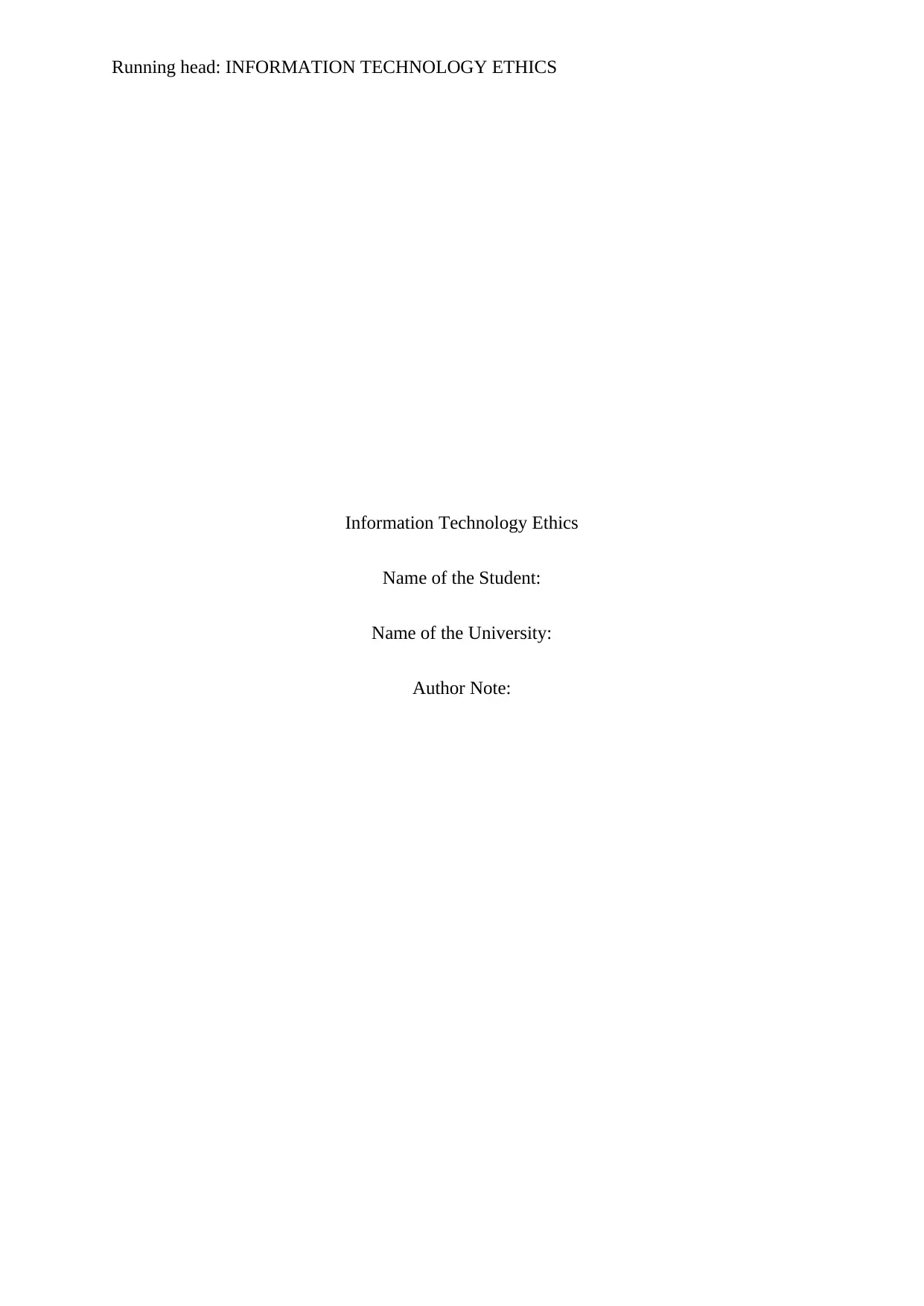
Running head: INFORMATION TECHNOLOGY ETHICS
Information Technology Ethics
Name of the Student:
Name of the University:
Author Note:
Information Technology Ethics
Name of the Student:
Name of the University:
Author Note:
Paraphrase This Document
Need a fresh take? Get an instant paraphrase of this document with our AI Paraphraser
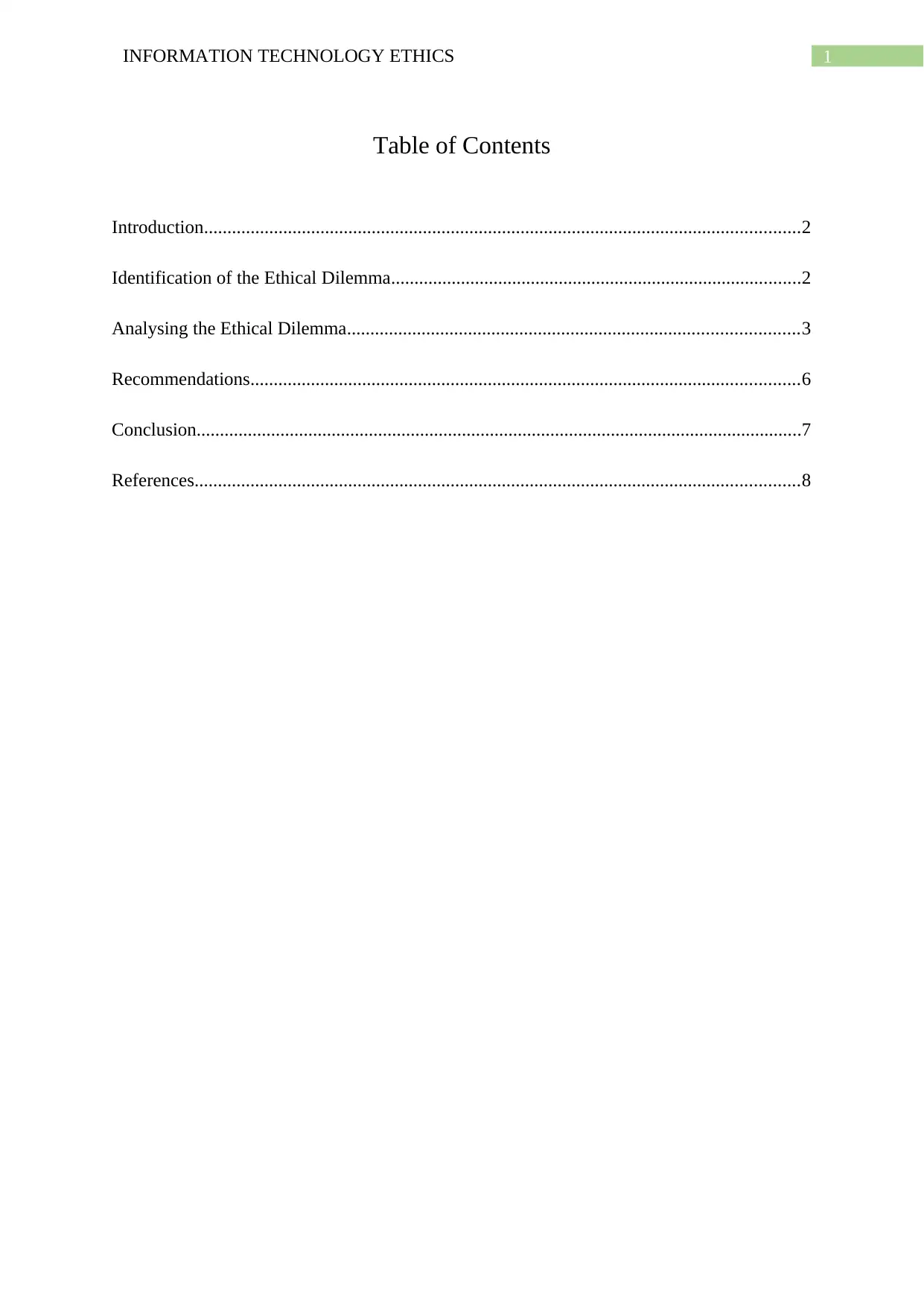
1INFORMATION TECHNOLOGY ETHICS
Table of Contents
Introduction................................................................................................................................2
Identification of the Ethical Dilemma........................................................................................2
Analysing the Ethical Dilemma.................................................................................................3
Recommendations......................................................................................................................6
Conclusion..................................................................................................................................7
References..................................................................................................................................8
Table of Contents
Introduction................................................................................................................................2
Identification of the Ethical Dilemma........................................................................................2
Analysing the Ethical Dilemma.................................................................................................3
Recommendations......................................................................................................................6
Conclusion..................................................................................................................................7
References..................................................................................................................................8
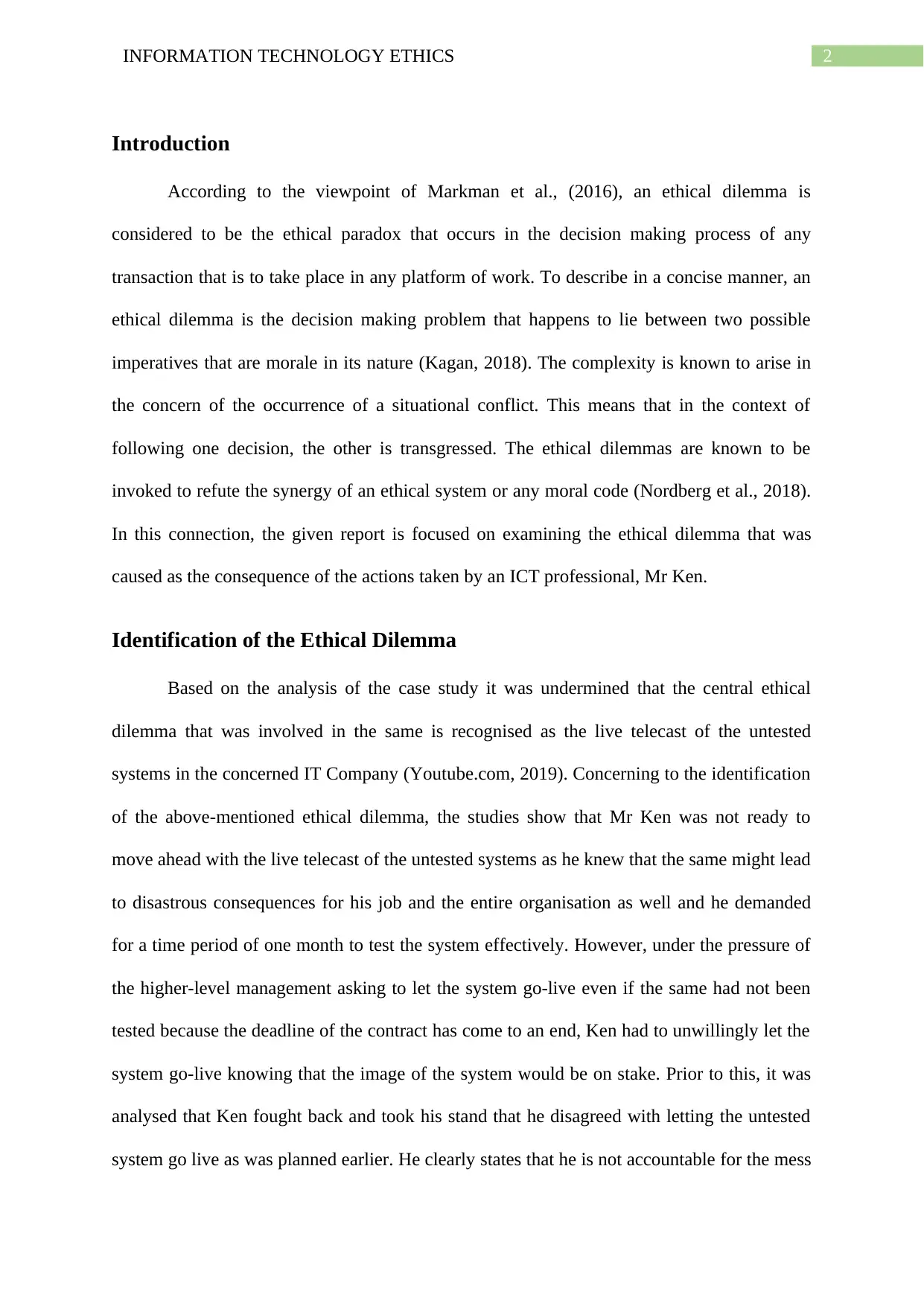
2INFORMATION TECHNOLOGY ETHICS
Introduction
According to the viewpoint of Markman et al., (2016), an ethical dilemma is
considered to be the ethical paradox that occurs in the decision making process of any
transaction that is to take place in any platform of work. To describe in a concise manner, an
ethical dilemma is the decision making problem that happens to lie between two possible
imperatives that are morale in its nature (Kagan, 2018). The complexity is known to arise in
the concern of the occurrence of a situational conflict. This means that in the context of
following one decision, the other is transgressed. The ethical dilemmas are known to be
invoked to refute the synergy of an ethical system or any moral code (Nordberg et al., 2018).
In this connection, the given report is focused on examining the ethical dilemma that was
caused as the consequence of the actions taken by an ICT professional, Mr Ken.
Identification of the Ethical Dilemma
Based on the analysis of the case study it was undermined that the central ethical
dilemma that was involved in the same is recognised as the live telecast of the untested
systems in the concerned IT Company (Youtube.com, 2019). Concerning to the identification
of the above-mentioned ethical dilemma, the studies show that Mr Ken was not ready to
move ahead with the live telecast of the untested systems as he knew that the same might lead
to disastrous consequences for his job and the entire organisation as well and he demanded
for a time period of one month to test the system effectively. However, under the pressure of
the higher-level management asking to let the system go-live even if the same had not been
tested because the deadline of the contract has come to an end, Ken had to unwillingly let the
system go-live knowing that the image of the system would be on stake. Prior to this, it was
analysed that Ken fought back and took his stand that he disagreed with letting the untested
system go live as was planned earlier. He clearly states that he is not accountable for the mess
Introduction
According to the viewpoint of Markman et al., (2016), an ethical dilemma is
considered to be the ethical paradox that occurs in the decision making process of any
transaction that is to take place in any platform of work. To describe in a concise manner, an
ethical dilemma is the decision making problem that happens to lie between two possible
imperatives that are morale in its nature (Kagan, 2018). The complexity is known to arise in
the concern of the occurrence of a situational conflict. This means that in the context of
following one decision, the other is transgressed. The ethical dilemmas are known to be
invoked to refute the synergy of an ethical system or any moral code (Nordberg et al., 2018).
In this connection, the given report is focused on examining the ethical dilemma that was
caused as the consequence of the actions taken by an ICT professional, Mr Ken.
Identification of the Ethical Dilemma
Based on the analysis of the case study it was undermined that the central ethical
dilemma that was involved in the same is recognised as the live telecast of the untested
systems in the concerned IT Company (Youtube.com, 2019). Concerning to the identification
of the above-mentioned ethical dilemma, the studies show that Mr Ken was not ready to
move ahead with the live telecast of the untested systems as he knew that the same might lead
to disastrous consequences for his job and the entire organisation as well and he demanded
for a time period of one month to test the system effectively. However, under the pressure of
the higher-level management asking to let the system go-live even if the same had not been
tested because the deadline of the contract has come to an end, Ken had to unwillingly let the
system go-live knowing that the image of the system would be on stake. Prior to this, it was
analysed that Ken fought back and took his stand that he disagreed with letting the untested
system go live as was planned earlier. He clearly states that he is not accountable for the mess
⊘ This is a preview!⊘
Do you want full access?
Subscribe today to unlock all pages.

Trusted by 1+ million students worldwide
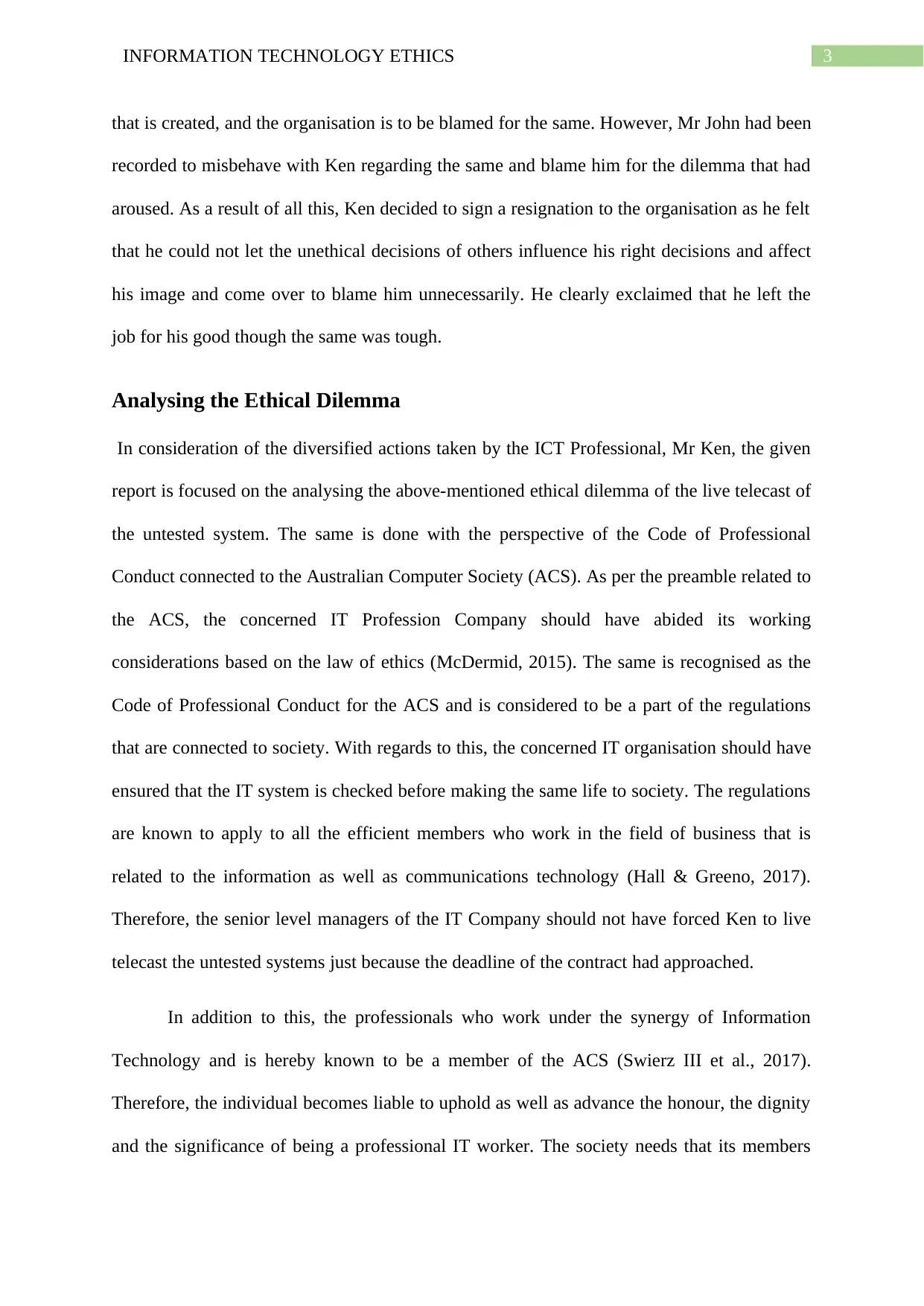
3INFORMATION TECHNOLOGY ETHICS
that is created, and the organisation is to be blamed for the same. However, Mr John had been
recorded to misbehave with Ken regarding the same and blame him for the dilemma that had
aroused. As a result of all this, Ken decided to sign a resignation to the organisation as he felt
that he could not let the unethical decisions of others influence his right decisions and affect
his image and come over to blame him unnecessarily. He clearly exclaimed that he left the
job for his good though the same was tough.
Analysing the Ethical Dilemma
In consideration of the diversified actions taken by the ICT Professional, Mr Ken, the given
report is focused on the analysing the above-mentioned ethical dilemma of the live telecast of
the untested system. The same is done with the perspective of the Code of Professional
Conduct connected to the Australian Computer Society (ACS). As per the preamble related to
the ACS, the concerned IT Profession Company should have abided its working
considerations based on the law of ethics (McDermid, 2015). The same is recognised as the
Code of Professional Conduct for the ACS and is considered to be a part of the regulations
that are connected to society. With regards to this, the concerned IT organisation should have
ensured that the IT system is checked before making the same life to society. The regulations
are known to apply to all the efficient members who work in the field of business that is
related to the information as well as communications technology (Hall & Greeno, 2017).
Therefore, the senior level managers of the IT Company should not have forced Ken to live
telecast the untested systems just because the deadline of the contract had approached.
In addition to this, the professionals who work under the synergy of Information
Technology and is hereby known to be a member of the ACS (Swierz III et al., 2017).
Therefore, the individual becomes liable to uphold as well as advance the honour, the dignity
and the significance of being a professional IT worker. The society needs that its members
that is created, and the organisation is to be blamed for the same. However, Mr John had been
recorded to misbehave with Ken regarding the same and blame him for the dilemma that had
aroused. As a result of all this, Ken decided to sign a resignation to the organisation as he felt
that he could not let the unethical decisions of others influence his right decisions and affect
his image and come over to blame him unnecessarily. He clearly exclaimed that he left the
job for his good though the same was tough.
Analysing the Ethical Dilemma
In consideration of the diversified actions taken by the ICT Professional, Mr Ken, the given
report is focused on the analysing the above-mentioned ethical dilemma of the live telecast of
the untested system. The same is done with the perspective of the Code of Professional
Conduct connected to the Australian Computer Society (ACS). As per the preamble related to
the ACS, the concerned IT Profession Company should have abided its working
considerations based on the law of ethics (McDermid, 2015). The same is recognised as the
Code of Professional Conduct for the ACS and is considered to be a part of the regulations
that are connected to society. With regards to this, the concerned IT organisation should have
ensured that the IT system is checked before making the same life to society. The regulations
are known to apply to all the efficient members who work in the field of business that is
related to the information as well as communications technology (Hall & Greeno, 2017).
Therefore, the senior level managers of the IT Company should not have forced Ken to live
telecast the untested systems just because the deadline of the contract had approached.
In addition to this, the professionals who work under the synergy of Information
Technology and is hereby known to be a member of the ACS (Swierz III et al., 2017).
Therefore, the individual becomes liable to uphold as well as advance the honour, the dignity
and the significance of being a professional IT worker. The society needs that its members
Paraphrase This Document
Need a fresh take? Get an instant paraphrase of this document with our AI Paraphraser
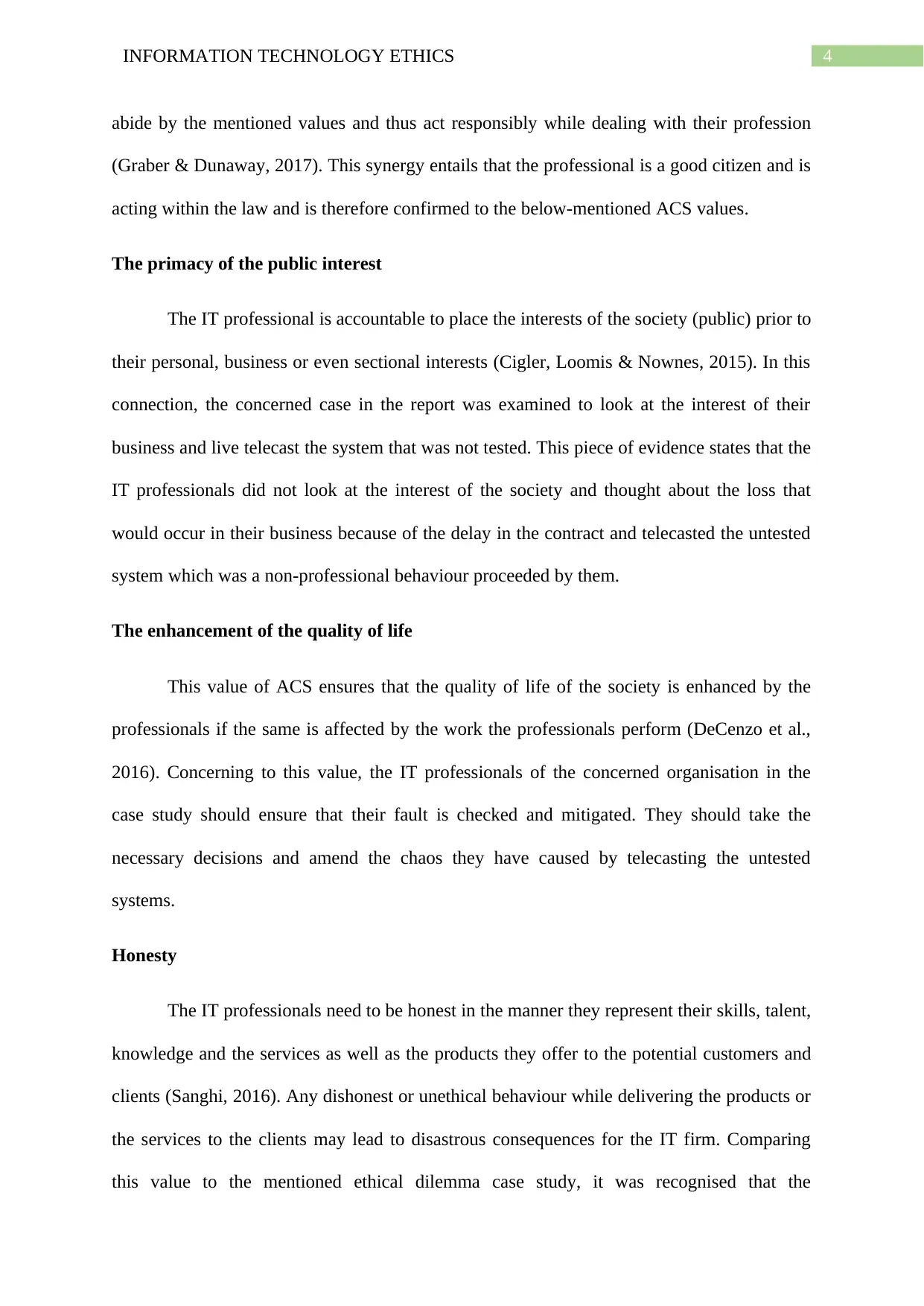
4INFORMATION TECHNOLOGY ETHICS
abide by the mentioned values and thus act responsibly while dealing with their profession
(Graber & Dunaway, 2017). This synergy entails that the professional is a good citizen and is
acting within the law and is therefore confirmed to the below-mentioned ACS values.
The primacy of the public interest
The IT professional is accountable to place the interests of the society (public) prior to
their personal, business or even sectional interests (Cigler, Loomis & Nownes, 2015). In this
connection, the concerned case in the report was examined to look at the interest of their
business and live telecast the system that was not tested. This piece of evidence states that the
IT professionals did not look at the interest of the society and thought about the loss that
would occur in their business because of the delay in the contract and telecasted the untested
system which was a non-professional behaviour proceeded by them.
The enhancement of the quality of life
This value of ACS ensures that the quality of life of the society is enhanced by the
professionals if the same is affected by the work the professionals perform (DeCenzo et al.,
2016). Concerning to this value, the IT professionals of the concerned organisation in the
case study should ensure that their fault is checked and mitigated. They should take the
necessary decisions and amend the chaos they have caused by telecasting the untested
systems.
Honesty
The IT professionals need to be honest in the manner they represent their skills, talent,
knowledge and the services as well as the products they offer to the potential customers and
clients (Sanghi, 2016). Any dishonest or unethical behaviour while delivering the products or
the services to the clients may lead to disastrous consequences for the IT firm. Comparing
this value to the mentioned ethical dilemma case study, it was recognised that the
abide by the mentioned values and thus act responsibly while dealing with their profession
(Graber & Dunaway, 2017). This synergy entails that the professional is a good citizen and is
acting within the law and is therefore confirmed to the below-mentioned ACS values.
The primacy of the public interest
The IT professional is accountable to place the interests of the society (public) prior to
their personal, business or even sectional interests (Cigler, Loomis & Nownes, 2015). In this
connection, the concerned case in the report was examined to look at the interest of their
business and live telecast the system that was not tested. This piece of evidence states that the
IT professionals did not look at the interest of the society and thought about the loss that
would occur in their business because of the delay in the contract and telecasted the untested
system which was a non-professional behaviour proceeded by them.
The enhancement of the quality of life
This value of ACS ensures that the quality of life of the society is enhanced by the
professionals if the same is affected by the work the professionals perform (DeCenzo et al.,
2016). Concerning to this value, the IT professionals of the concerned organisation in the
case study should ensure that their fault is checked and mitigated. They should take the
necessary decisions and amend the chaos they have caused by telecasting the untested
systems.
Honesty
The IT professionals need to be honest in the manner they represent their skills, talent,
knowledge and the services as well as the products they offer to the potential customers and
clients (Sanghi, 2016). Any dishonest or unethical behaviour while delivering the products or
the services to the clients may lead to disastrous consequences for the IT firm. Comparing
this value to the mentioned ethical dilemma case study, it was recognised that the
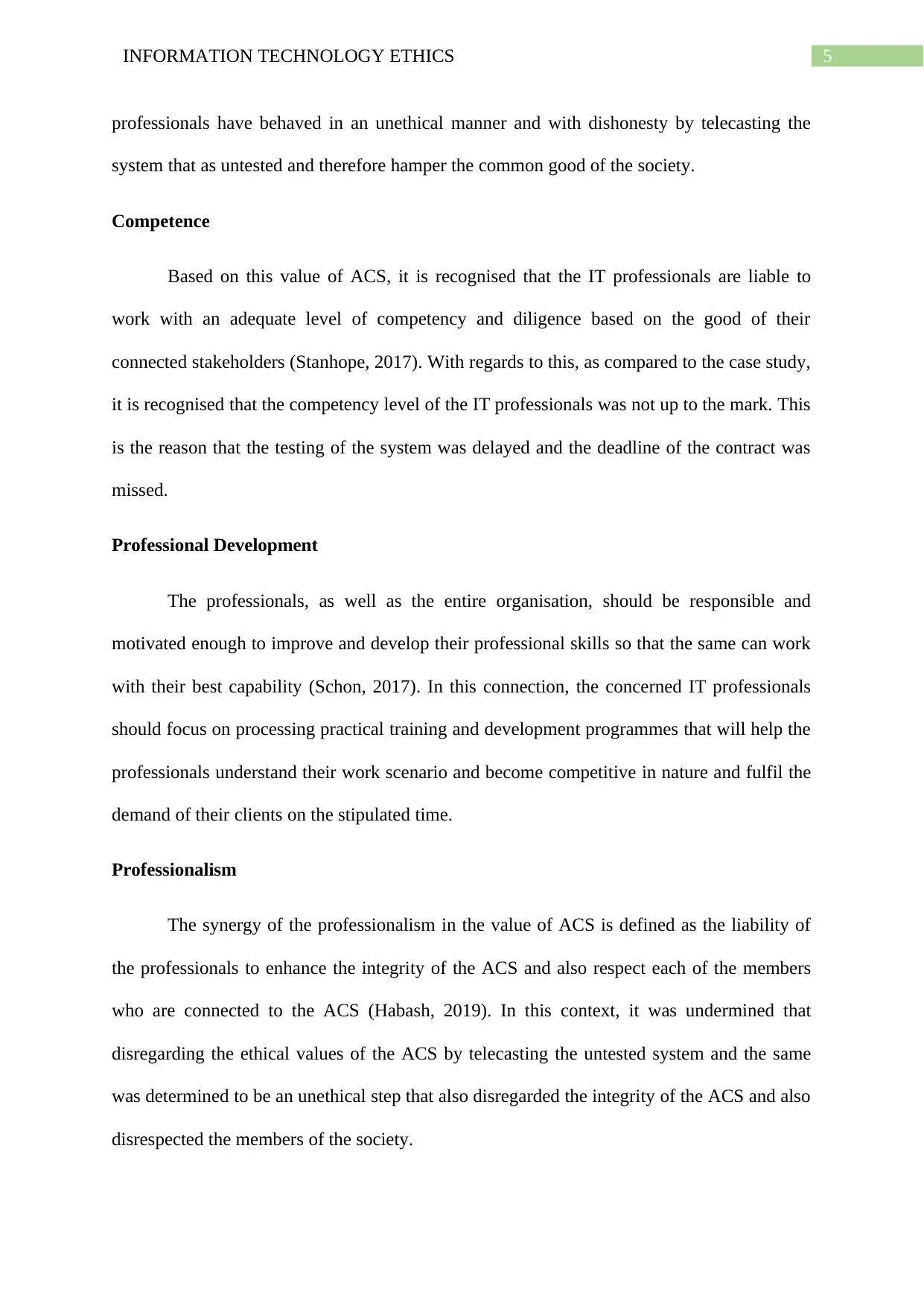
5INFORMATION TECHNOLOGY ETHICS
professionals have behaved in an unethical manner and with dishonesty by telecasting the
system that as untested and therefore hamper the common good of the society.
Competence
Based on this value of ACS, it is recognised that the IT professionals are liable to
work with an adequate level of competency and diligence based on the good of their
connected stakeholders (Stanhope, 2017). With regards to this, as compared to the case study,
it is recognised that the competency level of the IT professionals was not up to the mark. This
is the reason that the testing of the system was delayed and the deadline of the contract was
missed.
Professional Development
The professionals, as well as the entire organisation, should be responsible and
motivated enough to improve and develop their professional skills so that the same can work
with their best capability (Schon, 2017). In this connection, the concerned IT professionals
should focus on processing practical training and development programmes that will help the
professionals understand their work scenario and become competitive in nature and fulfil the
demand of their clients on the stipulated time.
Professionalism
The synergy of the professionalism in the value of ACS is defined as the liability of
the professionals to enhance the integrity of the ACS and also respect each of the members
who are connected to the ACS (Habash, 2019). In this context, it was undermined that
disregarding the ethical values of the ACS by telecasting the untested system and the same
was determined to be an unethical step that also disregarded the integrity of the ACS and also
disrespected the members of the society.
professionals have behaved in an unethical manner and with dishonesty by telecasting the
system that as untested and therefore hamper the common good of the society.
Competence
Based on this value of ACS, it is recognised that the IT professionals are liable to
work with an adequate level of competency and diligence based on the good of their
connected stakeholders (Stanhope, 2017). With regards to this, as compared to the case study,
it is recognised that the competency level of the IT professionals was not up to the mark. This
is the reason that the testing of the system was delayed and the deadline of the contract was
missed.
Professional Development
The professionals, as well as the entire organisation, should be responsible and
motivated enough to improve and develop their professional skills so that the same can work
with their best capability (Schon, 2017). In this connection, the concerned IT professionals
should focus on processing practical training and development programmes that will help the
professionals understand their work scenario and become competitive in nature and fulfil the
demand of their clients on the stipulated time.
Professionalism
The synergy of the professionalism in the value of ACS is defined as the liability of
the professionals to enhance the integrity of the ACS and also respect each of the members
who are connected to the ACS (Habash, 2019). In this context, it was undermined that
disregarding the ethical values of the ACS by telecasting the untested system and the same
was determined to be an unethical step that also disregarded the integrity of the ACS and also
disrespected the members of the society.
⊘ This is a preview!⊘
Do you want full access?
Subscribe today to unlock all pages.

Trusted by 1+ million students worldwide
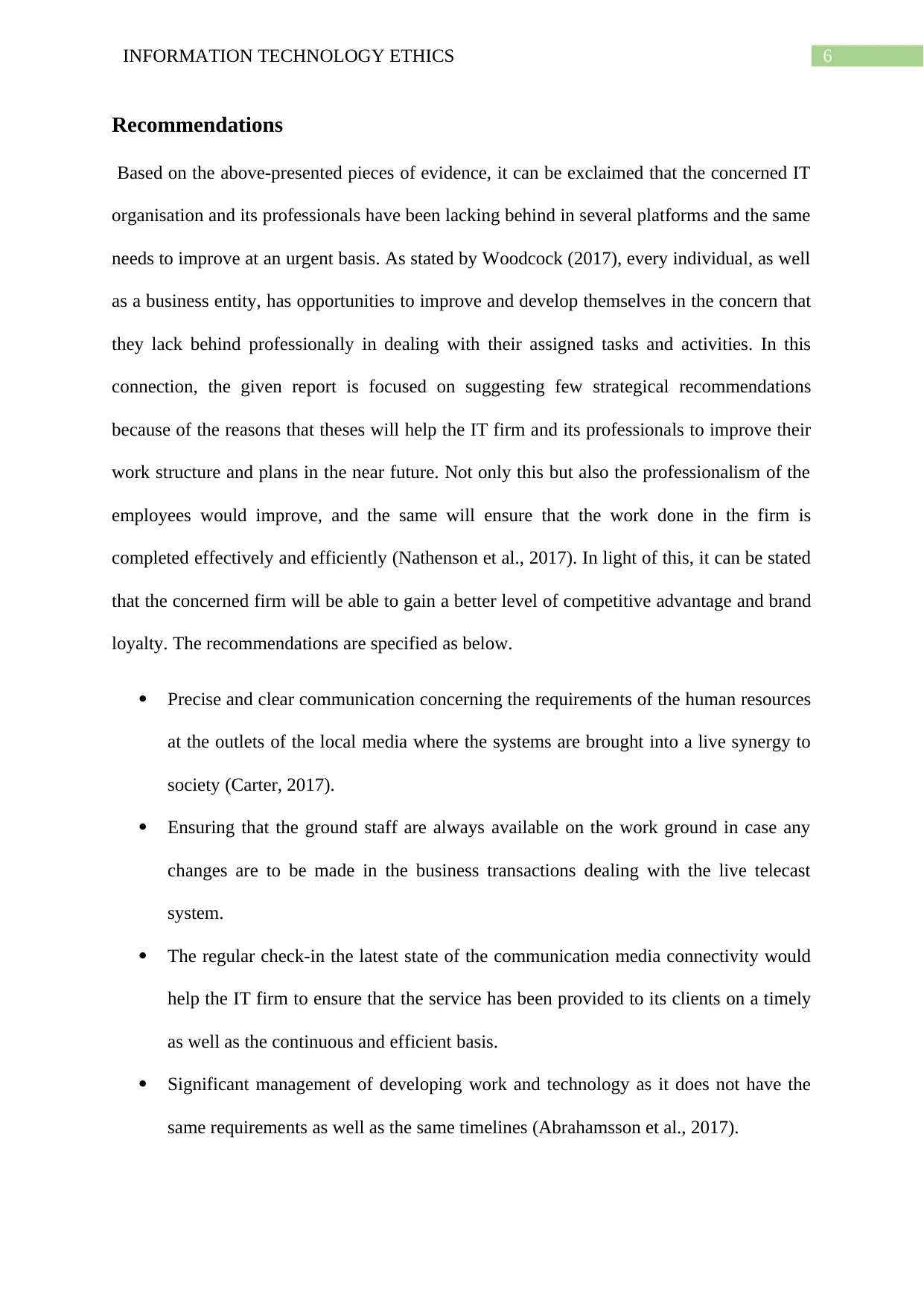
6INFORMATION TECHNOLOGY ETHICS
Recommendations
Based on the above-presented pieces of evidence, it can be exclaimed that the concerned IT
organisation and its professionals have been lacking behind in several platforms and the same
needs to improve at an urgent basis. As stated by Woodcock (2017), every individual, as well
as a business entity, has opportunities to improve and develop themselves in the concern that
they lack behind professionally in dealing with their assigned tasks and activities. In this
connection, the given report is focused on suggesting few strategical recommendations
because of the reasons that theses will help the IT firm and its professionals to improve their
work structure and plans in the near future. Not only this but also the professionalism of the
employees would improve, and the same will ensure that the work done in the firm is
completed effectively and efficiently (Nathenson et al., 2017). In light of this, it can be stated
that the concerned firm will be able to gain a better level of competitive advantage and brand
loyalty. The recommendations are specified as below.
Precise and clear communication concerning the requirements of the human resources
at the outlets of the local media where the systems are brought into a live synergy to
society (Carter, 2017).
Ensuring that the ground staff are always available on the work ground in case any
changes are to be made in the business transactions dealing with the live telecast
system.
The regular check-in the latest state of the communication media connectivity would
help the IT firm to ensure that the service has been provided to its clients on a timely
as well as the continuous and efficient basis.
Significant management of developing work and technology as it does not have the
same requirements as well as the same timelines (Abrahamsson et al., 2017).
Recommendations
Based on the above-presented pieces of evidence, it can be exclaimed that the concerned IT
organisation and its professionals have been lacking behind in several platforms and the same
needs to improve at an urgent basis. As stated by Woodcock (2017), every individual, as well
as a business entity, has opportunities to improve and develop themselves in the concern that
they lack behind professionally in dealing with their assigned tasks and activities. In this
connection, the given report is focused on suggesting few strategical recommendations
because of the reasons that theses will help the IT firm and its professionals to improve their
work structure and plans in the near future. Not only this but also the professionalism of the
employees would improve, and the same will ensure that the work done in the firm is
completed effectively and efficiently (Nathenson et al., 2017). In light of this, it can be stated
that the concerned firm will be able to gain a better level of competitive advantage and brand
loyalty. The recommendations are specified as below.
Precise and clear communication concerning the requirements of the human resources
at the outlets of the local media where the systems are brought into a live synergy to
society (Carter, 2017).
Ensuring that the ground staff are always available on the work ground in case any
changes are to be made in the business transactions dealing with the live telecast
system.
The regular check-in the latest state of the communication media connectivity would
help the IT firm to ensure that the service has been provided to its clients on a timely
as well as the continuous and efficient basis.
Significant management of developing work and technology as it does not have the
same requirements as well as the same timelines (Abrahamsson et al., 2017).
Paraphrase This Document
Need a fresh take? Get an instant paraphrase of this document with our AI Paraphraser
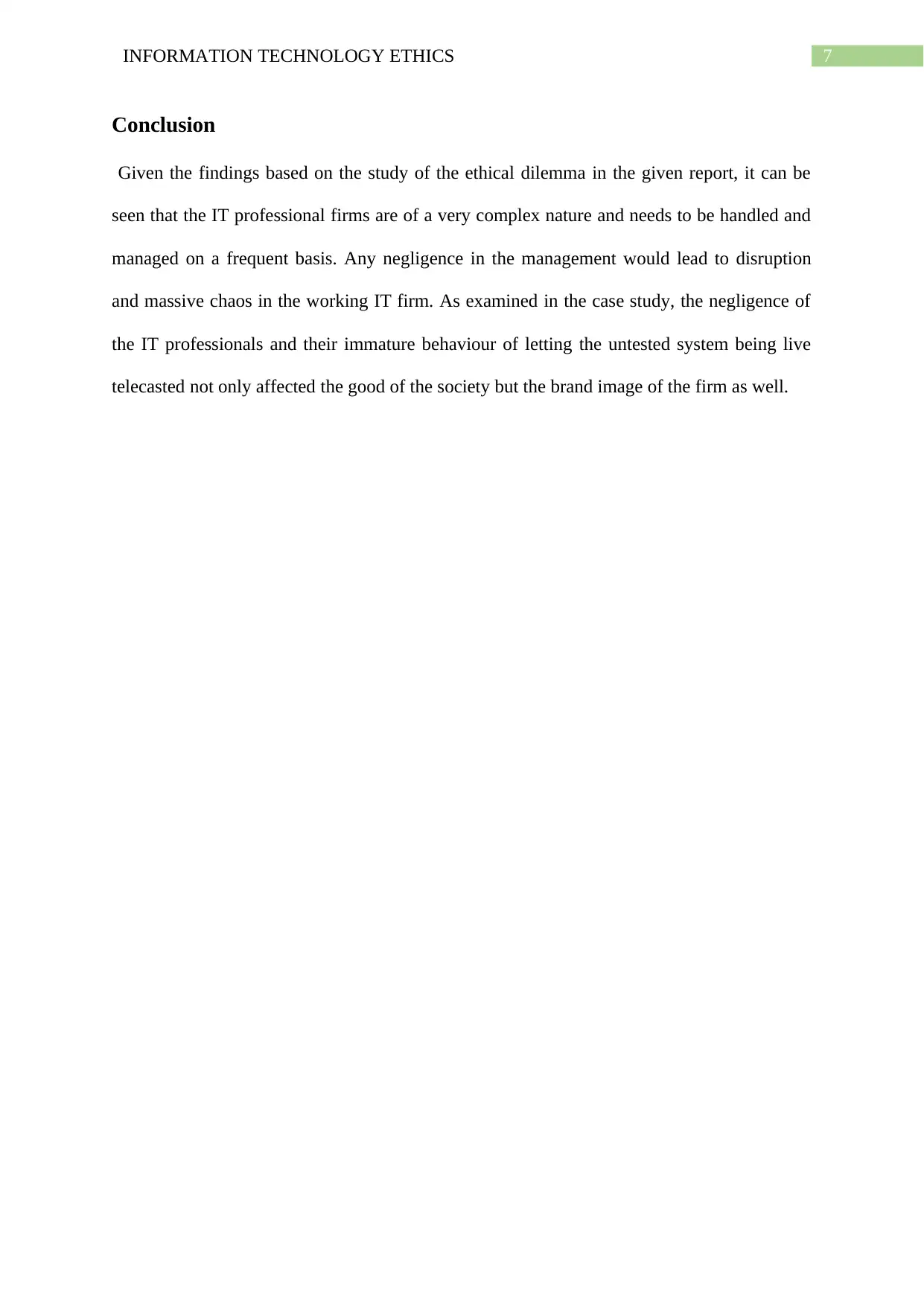
7INFORMATION TECHNOLOGY ETHICS
Conclusion
Given the findings based on the study of the ethical dilemma in the given report, it can be
seen that the IT professional firms are of a very complex nature and needs to be handled and
managed on a frequent basis. Any negligence in the management would lead to disruption
and massive chaos in the working IT firm. As examined in the case study, the negligence of
the IT professionals and their immature behaviour of letting the untested system being live
telecasted not only affected the good of the society but the brand image of the firm as well.
Conclusion
Given the findings based on the study of the ethical dilemma in the given report, it can be
seen that the IT professional firms are of a very complex nature and needs to be handled and
managed on a frequent basis. Any negligence in the management would lead to disruption
and massive chaos in the working IT firm. As examined in the case study, the negligence of
the IT professionals and their immature behaviour of letting the untested system being live
telecasted not only affected the good of the society but the brand image of the firm as well.
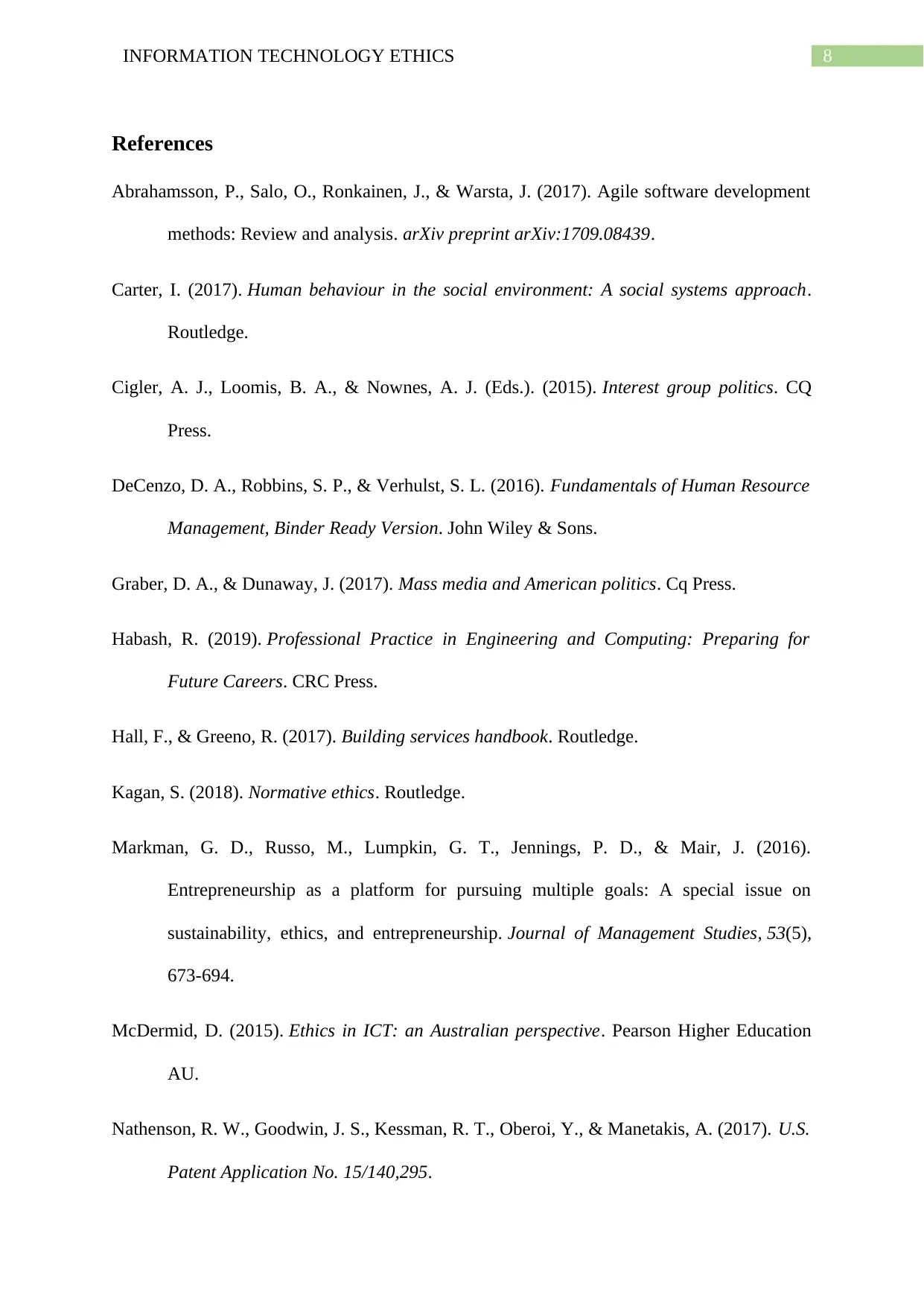
8INFORMATION TECHNOLOGY ETHICS
References
Abrahamsson, P., Salo, O., Ronkainen, J., & Warsta, J. (2017). Agile software development
methods: Review and analysis. arXiv preprint arXiv:1709.08439.
Carter, I. (2017). Human behaviour in the social environment: A social systems approach.
Routledge.
Cigler, A. J., Loomis, B. A., & Nownes, A. J. (Eds.). (2015). Interest group politics. CQ
Press.
DeCenzo, D. A., Robbins, S. P., & Verhulst, S. L. (2016). Fundamentals of Human Resource
Management, Binder Ready Version. John Wiley & Sons.
Graber, D. A., & Dunaway, J. (2017). Mass media and American politics. Cq Press.
Habash, R. (2019). Professional Practice in Engineering and Computing: Preparing for
Future Careers. CRC Press.
Hall, F., & Greeno, R. (2017). Building services handbook. Routledge.
Kagan, S. (2018). Normative ethics. Routledge.
Markman, G. D., Russo, M., Lumpkin, G. T., Jennings, P. D., & Mair, J. (2016).
Entrepreneurship as a platform for pursuing multiple goals: A special issue on
sustainability, ethics, and entrepreneurship. Journal of Management Studies, 53(5),
673-694.
McDermid, D. (2015). Ethics in ICT: an Australian perspective. Pearson Higher Education
AU.
Nathenson, R. W., Goodwin, J. S., Kessman, R. T., Oberoi, Y., & Manetakis, A. (2017). U.S.
Patent Application No. 15/140,295.
References
Abrahamsson, P., Salo, O., Ronkainen, J., & Warsta, J. (2017). Agile software development
methods: Review and analysis. arXiv preprint arXiv:1709.08439.
Carter, I. (2017). Human behaviour in the social environment: A social systems approach.
Routledge.
Cigler, A. J., Loomis, B. A., & Nownes, A. J. (Eds.). (2015). Interest group politics. CQ
Press.
DeCenzo, D. A., Robbins, S. P., & Verhulst, S. L. (2016). Fundamentals of Human Resource
Management, Binder Ready Version. John Wiley & Sons.
Graber, D. A., & Dunaway, J. (2017). Mass media and American politics. Cq Press.
Habash, R. (2019). Professional Practice in Engineering and Computing: Preparing for
Future Careers. CRC Press.
Hall, F., & Greeno, R. (2017). Building services handbook. Routledge.
Kagan, S. (2018). Normative ethics. Routledge.
Markman, G. D., Russo, M., Lumpkin, G. T., Jennings, P. D., & Mair, J. (2016).
Entrepreneurship as a platform for pursuing multiple goals: A special issue on
sustainability, ethics, and entrepreneurship. Journal of Management Studies, 53(5),
673-694.
McDermid, D. (2015). Ethics in ICT: an Australian perspective. Pearson Higher Education
AU.
Nathenson, R. W., Goodwin, J. S., Kessman, R. T., Oberoi, Y., & Manetakis, A. (2017). U.S.
Patent Application No. 15/140,295.
⊘ This is a preview!⊘
Do you want full access?
Subscribe today to unlock all pages.

Trusted by 1+ million students worldwide
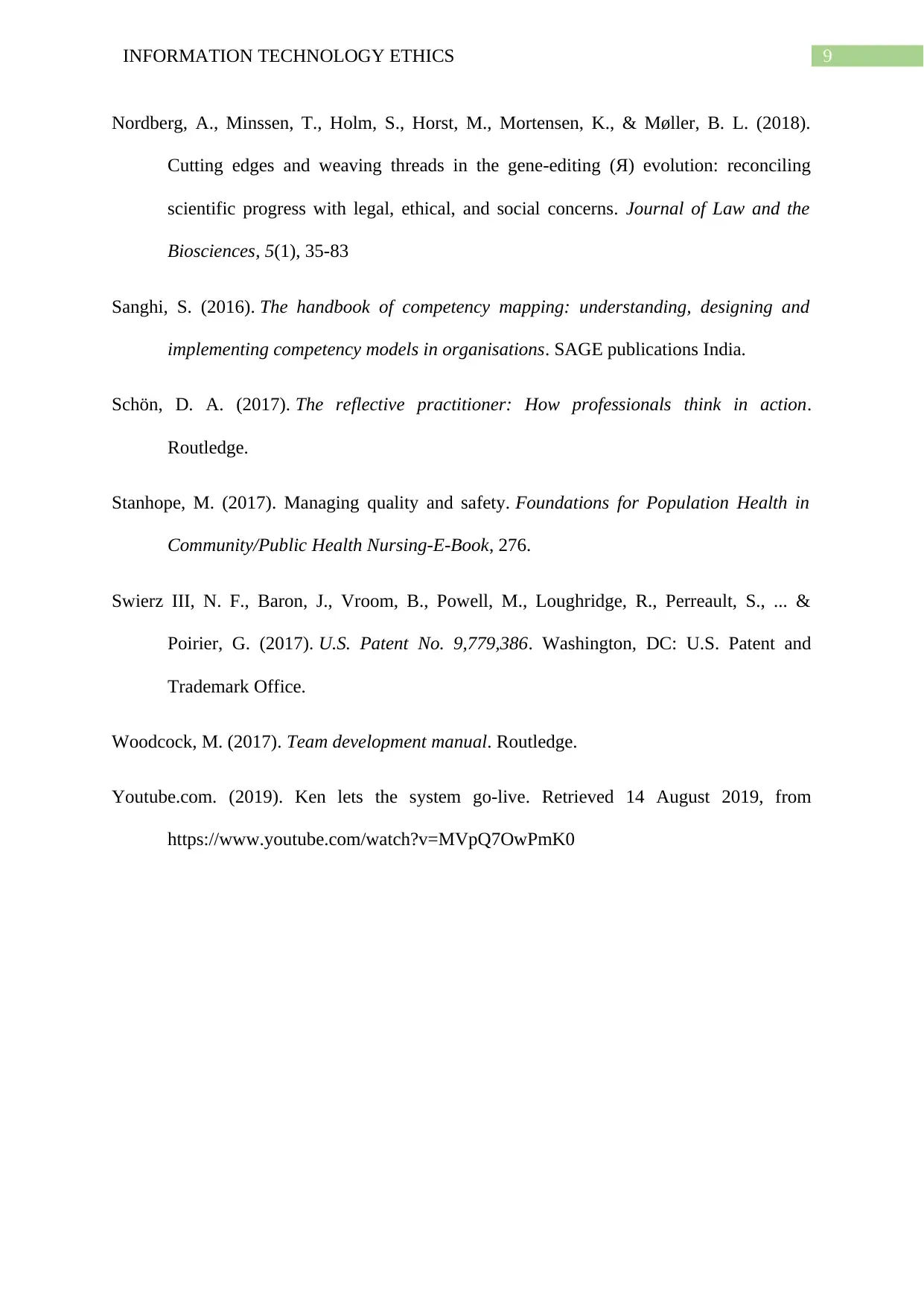
9INFORMATION TECHNOLOGY ETHICS
Nordberg, A., Minssen, T., Holm, S., Horst, M., Mortensen, K., & Møller, B. L. (2018).
Cutting edges and weaving threads in the gene-editing (Я) evolution: reconciling
scientific progress with legal, ethical, and social concerns. Journal of Law and the
Biosciences, 5(1), 35-83
Sanghi, S. (2016). The handbook of competency mapping: understanding, designing and
implementing competency models in organisations. SAGE publications India.
Schön, D. A. (2017). The reflective practitioner: How professionals think in action.
Routledge.
Stanhope, M. (2017). Managing quality and safety. Foundations for Population Health in
Community/Public Health Nursing-E-Book, 276.
Swierz III, N. F., Baron, J., Vroom, B., Powell, M., Loughridge, R., Perreault, S., ... &
Poirier, G. (2017). U.S. Patent No. 9,779,386. Washington, DC: U.S. Patent and
Trademark Office.
Woodcock, M. (2017). Team development manual. Routledge.
Youtube.com. (2019). Ken lets the system go-live. Retrieved 14 August 2019, from
https://www.youtube.com/watch?v=MVpQ7OwPmK0
Nordberg, A., Minssen, T., Holm, S., Horst, M., Mortensen, K., & Møller, B. L. (2018).
Cutting edges and weaving threads in the gene-editing (Я) evolution: reconciling
scientific progress with legal, ethical, and social concerns. Journal of Law and the
Biosciences, 5(1), 35-83
Sanghi, S. (2016). The handbook of competency mapping: understanding, designing and
implementing competency models in organisations. SAGE publications India.
Schön, D. A. (2017). The reflective practitioner: How professionals think in action.
Routledge.
Stanhope, M. (2017). Managing quality and safety. Foundations for Population Health in
Community/Public Health Nursing-E-Book, 276.
Swierz III, N. F., Baron, J., Vroom, B., Powell, M., Loughridge, R., Perreault, S., ... &
Poirier, G. (2017). U.S. Patent No. 9,779,386. Washington, DC: U.S. Patent and
Trademark Office.
Woodcock, M. (2017). Team development manual. Routledge.
Youtube.com. (2019). Ken lets the system go-live. Retrieved 14 August 2019, from
https://www.youtube.com/watch?v=MVpQ7OwPmK0
1 out of 10
Related Documents
Your All-in-One AI-Powered Toolkit for Academic Success.
+13062052269
info@desklib.com
Available 24*7 on WhatsApp / Email
![[object Object]](/_next/static/media/star-bottom.7253800d.svg)
Unlock your academic potential
Copyright © 2020–2025 A2Z Services. All Rights Reserved. Developed and managed by ZUCOL.




